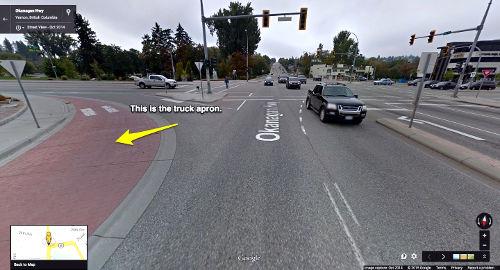Roundabouts are better than conventional intersections at moving traffic through urban areas.
When talking to my students that have been with other driver instructors during the course of their tractor-trailer training, I often say:
“Show me 50 driving instructors & I’ll show you 50 ways to drive a truck.”
Like many professions and trades, there are many paths to the final destination.
Some times however, the information that professionals impart is erroneous.
Yet this mistake is part-and-parcel of a larger problem that exits.
In the three fundamental facets of traffic safety:
1) Engineering
2) Education
3) Enforcement
One facet of the three elements of road safety often lags behind the others two.
In the case of truck aprons, road engineers have formulated and brought these to our roadways, but provided little, if any education to the commercial driving sector.
Roundabouts
Truck aprons are part of roundabouts' design to allow larger vehicles room to navigate without striking fixed objects or other road users.
Unfortunately, Canada’s drivers’ manuals provide little information about truck aprons.
For that matter, Wikipedia—the world’s most recognized electronic resource for information—has a full description of roundabouts, but it offers little beyond a highfalutin definition for truck aprons:
The inner annulus [a ring-shaped object, structure, or region] provides for the trailing axles of longer or articulated vehicles to sweep across the inner annulus, which is therefore known as an over-run area (in UK usage), truck apron, or mountable apron.1
BC’s Driving Commercial Vehicles states:
Traffic circles and roundabouts often have a truck apron around the edge of the island in he middle.
Large vehicles may need to drive over the apron in order to drive through the traffic circle or roundabout.2
The Ministry of Transport in Ontario offers no elaboration over BC’s driving manual for truck aprons stating:
Large vehicles
Large vehicles may need to use more than one lane when they enter, drive through and exit a roundabout.
Within the roundabout, they may also need to use the truck apron.
Give large vehicles plenty of room to navigate.3
Other provincial authorities echo similar sentiments regarding truck aprons and roundabouts.
The Alberta government provides the most detailed information regarding roundabouts and truck aprons.
They offer a video and in it state:
“Truck aprons are designed to support the weight of large trucks and help long vehicles turn safely through roundabouts.”4
Most of the information regarding roundabouts and large commercial vehicles is—without surprise—related to larger roundabouts at major intersections.
Many smaller roundabouts—as in the image above—too have truck aprons.
Large commercial vehicles can simply drive across the truck apron to manoeuvre through the roundabout.
 Slip Lanes (Turning Lanes)
Slip Lanes (Turning Lanes)
In Vernon, BC, where I live and work, the use of truck aprons has been extended from roundabouts to widen and broaden slip lanes (turning lanes) at bigger intersections.
These intersections have a high commercial vehicles (18-wheeler, Super ‘B’ and Greyhound buses) traffic volume owing to the timber & chip mills in the region.
Truck aprons heretofore associated with roundabouts have been extended to slip lanes to accommodate larger vehicles turning right or making tight turns.
Many commercial drivers however, are of the belief that the truck apron portion of the slip lane is for decoration and should not be driven on with the trailer portion of their unit.5
The notion that it is simple decoration is understandable and has been documented by road engineers.
Unfortunately, planners', designers', and builders' attempted to make truck aprons and roundabouts more attractive by stamping and colouring the concrete.
From a distance the concrete looks like red paving stones.
Consequently, many commercial drivers do not use these for their intended purpose.
Facilitating Traffic Flow
However, the purpose of the truck apron on the slip lane is to allow the semi-trucks or large vehicle to proceed around the turn without proceeding into the far lane of the intersecting road.
In other words, the truck and trailer can stay on the right-hand lane of the road onto which it is turning without moving into the left-hand lane.
This feature allows other traffic proceeding through the intersection to not be impeded or obstructed by the larger turning vehicle.
With this advancement of road engineering safety is increased owing to the fact that turning commercial vehicles are no longer conflicting with an opposing line of traffic.
Conclusion
Truck aprons are used on roundabouts and slip lanes to compensate for the off-tracking of larger vehicles.
Although these look decorative, they are designed to withstand the weight of heavy trucks.
On some smaller roundabouts, the larger vehicle may have to proceed straight across the truck apron.
Truck aprons are used on slip lanes to compensate for a larger vehicle’s off-tracking and reduce the points of conflict in an intersection.
1 “Roundabouts,”Wikipedia, http://en.wikipedia.org/wiki/Roundabout, (12 April 2015).
2 Driving commercial vehicles: a guide for professional drivers, 2014, ICBC, 38.
3 “Highway Roundabouts” The Ministry of Transportation of Ontario, http://www.mto.gov.on.ca/english/ontario-511/roundabouts.shtml, (12 April 2015).
4 Alberta Government, “Roundabouts,” Alberta Transportation, (12 April 2015), http://www.transportation.alberta.ca/roundabouts.htm.
5 Ourston Roundabout Engineering Canada, "Accommodating Commercial And Overdimensional Vehicles At Roundabouts", 12 April 2015, http://conf.tac-atc.ca/english/annualconference/tac2011/docs/r5/weber.pdf.
“Observations have shown that truck drivers are sometimes reluctant to use truck aprons.
They may be unsure of their purpose, or think they look too nice to be driven over.
A yellow edge line around a central island apron may make them even more reluctant because it reminds them of a road centre line that should not be crossed.
A slip lane is a road traffic lane provided at an intersection to allow vehicles to turn at the intersection without actually entering it and interfering with through traffic."




